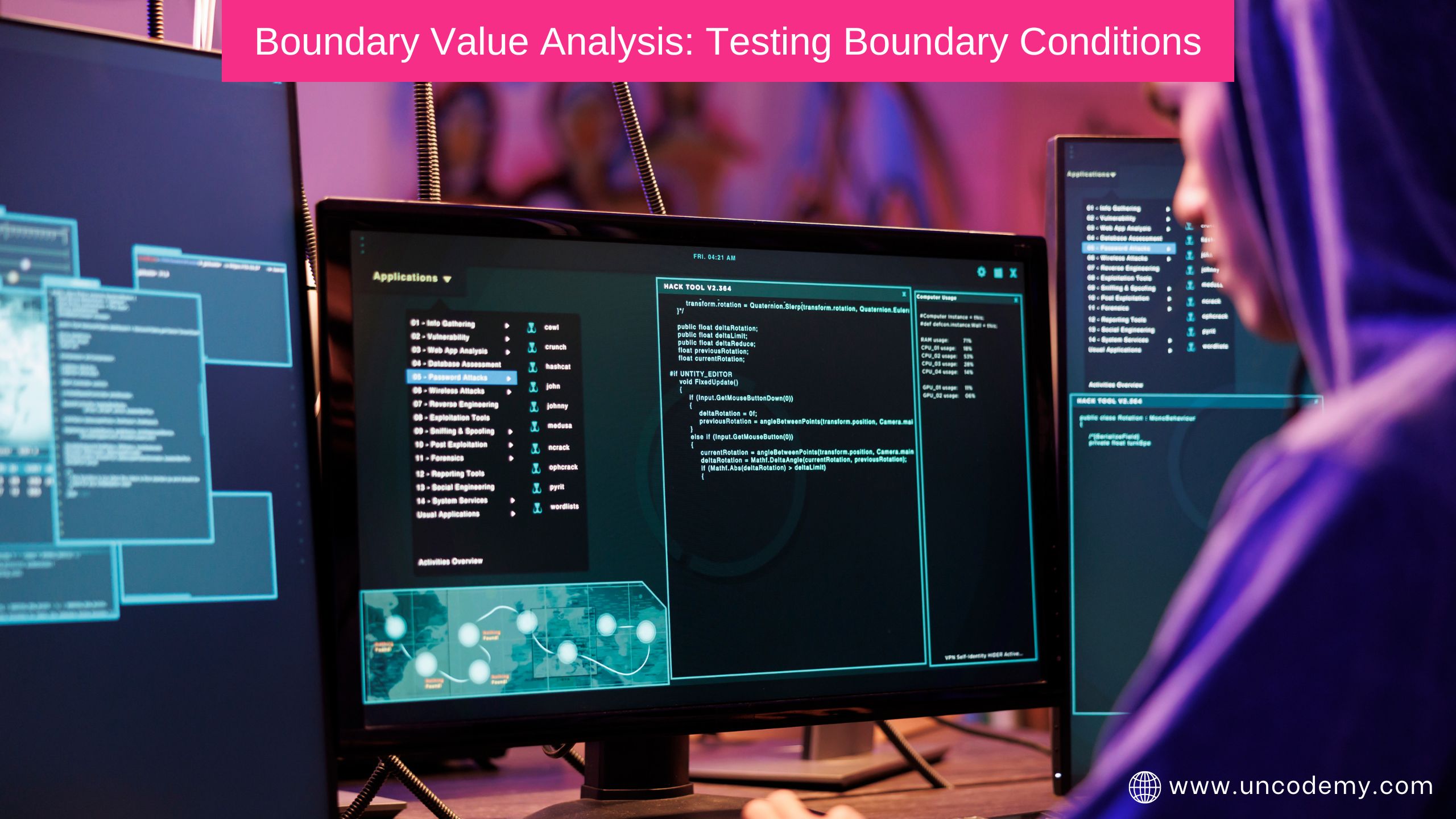Boundary Value Analysis (BVA) is a software testing technique used to identify and test boundary conditions around the input domain of a software application. It aims to ensure that the software behaves correctly at the boundaries of valid input ranges and can handle edge cases effectively. BVA is based on the principle that defects often occur near the boundaries of input ranges, making it crucial to thoroughly test these areas.
The primary objective of Boundary Value Analysis is to uncover defects related to boundary conditions, such as off-by-one errors, rounding errors, and boundary-related exceptions. By focusing on boundary values and their immediate neighbors, testers can identify potential issues that may not be evident during normal testing scenarios.
BVA is particularly useful for numerical inputs, where boundary conditions play a critical role in determining software behavior. However, it can also be applied to other types of input data, including strings, dates, and Boolean values.
Understanding Boundary Value Analysis:
Boundary Value Analysis (BVA) is a software testing technique used to identify defects around the boundaries of input domains. It operates on the principle that errors often occur at the edges or boundaries of ranges rather than within the range itself. BVA focuses on testing the values at the lower and upper boundaries, as well as the values immediately outside those boundaries.
For example, consider a function that accepts input values in the range of 1 to 100. In BVA, the test cases would include values like 0, 1, 2 (just below the lower boundary), 99, 100, and 101 (just above the upper boundary). By testing these boundary values, testers aim to uncover potential issues such as off-by-one errors, boundary-related calculations, and boundary-related loops.
BVA is commonly used alongside Equivalence Partitioning, another software testing technique. While Equivalence Partitioning focuses on testing representative values from each partition, BVA complements it by focusing specifically on the boundaries between partitions. Together, these techniques provide more comprehensive test coverage.
Importance of Boundary Value Analysis:
Boundary Value Analysis is essential for enhancing the effectiveness and efficiency of software testing. By focusing on boundary conditions, BVA helps identify defects that may not be apparent when testing values within the range. The importance of BVA can be understood through the following key points:
1. Defect Detection: BVA helps detect errors related to boundary conditions, such as off-by-one errors, array out-of-bounds errors, and buffer overflows. These errors are often critical and can lead to system failures or vulnerabilities if left undetected.
2. Test Coverage: BVA improves test coverage by targeting critical areas of the input domain. By testing boundary values, testers can ensure that the software behaves correctly at the edges of its permissible input range.
3. Efficiency: BVA provides a structured approach to testing boundary conditions, making the testing process more efficient. Testers can prioritize boundary tests based on their potential impact on system behavior and reliability.
4. Risk Reduction: By identifying and fixing defects early in the development lifecycle, BVA helps mitigate risks associated with boundary-related issues. This proactive approach minimizes the likelihood of encountering critical issues in production environments.
Steps for Performing Boundary Value Analysis:
Performing Boundary Value Analysis involves several steps to ensure comprehensive test coverage and effective defect detection:
1. Identify Input Boundaries: Begin by analyzing the input requirements or specifications of the software under test. Identify the input boundaries, including lower and upper limits, as well as any special boundary conditions specified in the requirements.
2. Define Boundary Test Cases: Based on the identified boundaries, define the boundary test cases. These test cases should include values at the lower boundary, just below the lower boundary, within the valid range, just above the upper boundary, and at the upper boundary.
3. Select Representative Values: Along with boundary values, select representative values from each equivalence partition. These values should be chosen to cover different scenarios and data types, ensuring thorough testing of the application’s functionality.
4. Create Test Scenarios: Develop test scenarios or test cases for each identified boundary and representative value. Document the expected behavior or outcomes for each test case to serve as a reference during execution.
5. Execute Test Cases: Execute the prepared test cases using the selected boundary and representative values. Monitor the application’s behavior and compare the actual results against the expected outcomes.
6. Analyze Results: Analyze the test results to identify any discrepancies between the expected and actual behavior. Record any defects or anomalies encountered during testing, including their severity and potential impact on the software.
7. Iterative Testing: Iterate the testing process as necessary, incorporating feedback from test execution and defect analysis. Modify test cases or add new test scenarios based on uncovered issues or changes in requirements.
Best Practices for Boundary Value Analysis:
To maximize the effectiveness of Boundary Value Analysis, consider the following best practices:
1. Coverage Criteria: Ensure that boundary tests cover all relevant boundary conditions, including lower, upper, and special boundaries specified in the requirements.
2. Equivalence Partitioning: Combine Boundary Value Analysis with Equivalence Partitioning to achieve comprehensive test coverage. Equivalence Partitioning helps identify representative values, while BVA focuses on boundary conditions.
3. Automated Testing: Implement automated testing frameworks or tools to streamline the execution of boundary test cases. Automation helps reduce manual effort, improves test efficiency, and facilitates regression testing.
4. Boundary Stress Testing: In addition to testing typical boundary conditions, perform stress testing by pushing boundaries beyond the specified limits. This helps identify potential system vulnerabilities or performance issues under extreme conditions.
5. Documentation: Maintain thorough documentation of boundary test cases, including input values, expected outcomes, and actual results. Documentation serves as a valuable reference for future testing cycles and facilitates knowledge sharing among team members.
6. Regular Review: Conduct regular reviews of boundary test cases to ensure they remain relevant and up-to-date with changes in requirements or system behavior. Update test cases as needed to reflect evolving project needs.
By following these best practices, organizations can effectively leverage Boundary Value Analysis to enhance the quality and reliability of their software systems.
Challenges of Boundary Value Analysis:
While Boundary Value Analysis is a powerful testing technique, it also presents several challenges that testers may encounter:
1. Complex Boundary Conditions: Some software systems may have complex boundary conditions that are difficult to identify or test comprehensively. Analyzing intricate boundary scenarios and designing corresponding test cases can be challenging and time-consuming.
2. Interactions Between Boundaries: In systems with multiple input parameters or interdependent variables, interactions between different boundaries may occur. Understanding and testing these interactions accurately require careful consideration and thorough testing.
3. Data Types and Formats: Boundary Value Analysis may be more complex for systems that handle diverse data types and formats. Testing boundaries for numeric, alphanumeric, or date/time inputs, as well as handling special characters or formatting constraints, can add complexity to the testing process.
4. Boundary Overlaps: Boundary values often overlap between different partitions, leading to ambiguity in test coverage. Identifying and addressing overlapping boundaries requires clear delineation and careful consideration of test scenarios.
5. Boundary Exceptions: Boundary conditions are often associated with exceptional or edge-case scenarios that may not follow typical application behavior. Testing these boundary exceptions thoroughly requires specialized test cases and consideration of potential error handling mechanisms.
6. Dynamic Systems: In dynamic systems where boundaries may change over time or in response to user actions, maintaining accurate boundary tests becomes challenging. Testers must adapt their testing strategies to accommodate dynamic boundary conditions effectively.
7. Test Data Generation: Generating comprehensive test data for boundary conditions can be time-consuming, especially in systems with a large input domain. Test data generation techniques such as randomization or data mining may be necessary to ensure adequate test coverage.
Mitigation Strategies:
To address the challenges associated with Boundary Value Analysis, testers can employ several mitigation strategies:
1. Collaborative Approach: Foster collaboration between development, testing, and business stakeholders to ensure a shared understanding of boundary conditions and test objectives.
2. Early Engagement: Involve testers early in the software development lifecycle to identify boundary conditions and design appropriate test cases from the outset.
3. Automation: Utilize test automation tools and frameworks to streamline the execution of boundary test cases, reduce manual effort, and enhance test efficiency.
4. Boundary Analysis Tools: Leverage specialized boundary analysis tools or libraries that can assist in identifying, analyzing, and testing boundary conditions effectively.
5. Regression Testing: Implement robust regression testing processes to validate boundary conditions across software releases and ensure that changes do not introduce unintended side effects.
6. Continuous Improvement: Regularly review and refine boundary test cases based on feedback from testing cycles, evolving requirements, and changes in system behavior. Continuously improve testing practices to enhance the effectiveness of Boundary Value Analysis over time.
By adopting these mitigation strategies, organizations can overcome the challenges associated with Boundary Value Analysis and maximize its benefits in ensuring software quality and reliability.
Conclusion
In conclusion, Boundary Value Analysis (BVA) is a valuable technique in software testing for identifying and addressing potential defects related to boundary conditions. By focusing testing efforts on the boundaries of input ranges, BVA helps uncover issues that may go unnoticed during normal testing scenarios. Its systematic approach enhances test coverage and improves the overall quality of software products. However, while BVA offers significant benefits, it is not without challenges. Testers must carefully design test cases and consider various factors, such as boundary values, neighboring values, and input constraints. Additionally, thorough documentation and communication are essential to ensure that BVA is applied effectively across the testing process.
By incorporating BVA into their testing methodologies and investing in comprehensive Software Testing Training Courses in Noida, organizations can strengthen their testing capabilities and deliver more reliable and robust software solutions to their customers.








2 Comments